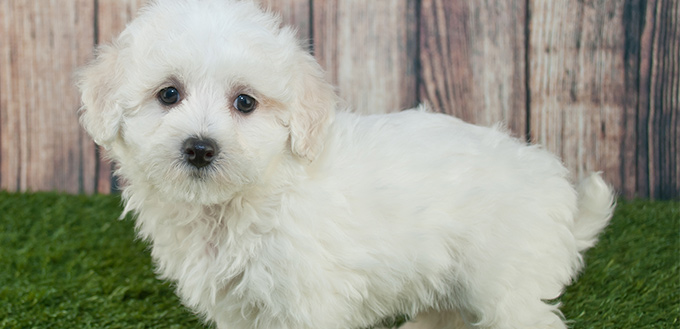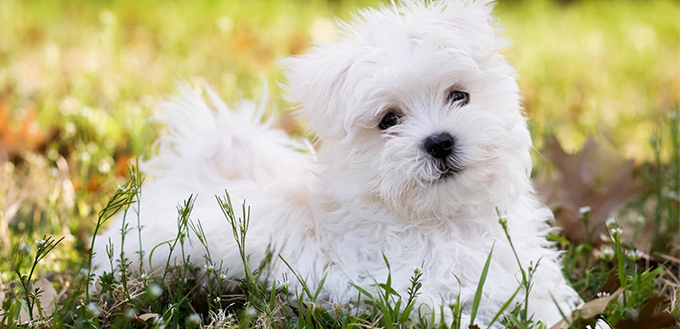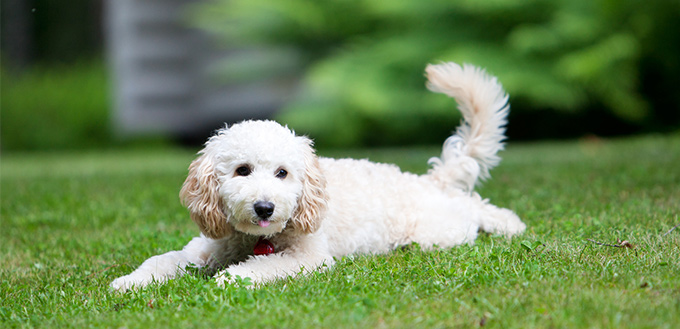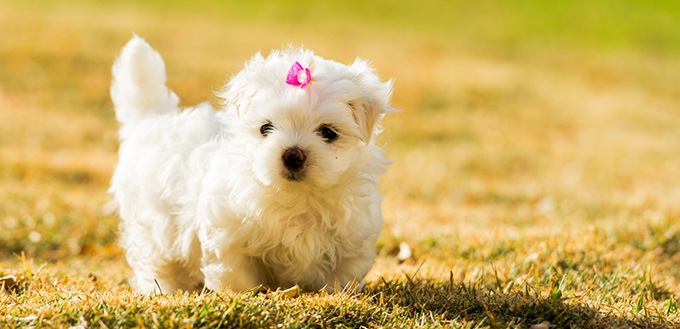One is gentle and fearless and can be a friend to almost anybody it meets. The other one is remarkably clever, possessing an intelligence that astounds even its pet parents. One has been around since 500 BC and perhaps even earlier while the other has been on man’s many exploits as early as the 15thcentury. We’re talking about the Poodle and the Maltese, numbers 7 and 33, respectively, on AKC’s most popular dog breeds. Crossbreeding these two dogs can result in a loving companion and a smart and darling canine friend, thanks to the great combination of a Poodle’s unmatched intelligence and a Maltese’s unparalleled sweetness. If you’re looking for the perfect therapy dog that is smart and lovable at the same time, the Maltipoo fits the bill perfectly.
History of the Maltipoo
Man has been trying to create a breed of dog that is more to his liking than what existing dogs have. Even the best and most-loved dogs underwent through a very meticulous process of selective breeding so that only the most positive, most desirable traits are transmitted into the offspring. Many of the dogs that we know today somehow have their origins in this manner.
However, designing a different breed takes time, often counting decades of careful breeding practices to achieve the desired characteristics. For the Maltipoo, crossing a Poodle with a Maltese presented quite unique challenges especially in the selection of a suitable Poodle. Everyone knows that there are 3 types of Poodles: standard, miniature, and toy. While it is technically possible to cross a male Maltese with a female standard Poodle, the disparity in size alone will mean an extraordinary mating capability on the part of the Maltese. That being said, it can only be achieved through artificial insemination, a process which some pet parents may not really want to go through just yet.

Mating a Maltese with either a toy or miniature Poodle, on the other hand, can help address such issues since they will be technically of the same height, more or less. This is especially true for the toy Poodle as the miniature Poodle will still be about 1 to 8 inches taller than the average Maltese. Nevertheless, mating a toy Poodle with a Maltese is actually more preferred as one can use either breeds as either the mother or father of the Maltipoo. If a miniature Poodle is used it is almost always the case that the Poodle be female and the Maltese male to allow for any size variation in the litter to be accommodated by the dog with a larger uterus.
As for the origins of the Maltipoo, no one actually knows where they came from or who designed the first cross between a Poodle and a Maltese. What is known is that these hybrids have steadily risen in popularity in the past 10, 20 years that experts believe it is still a long way to go before it can become a full-pledged purebred like the Doberman pinscher, the Australian shepherd, and the Leonberger, among other dogs that have been crossbred.
What is quite interesting, however, is that the Maltese have already been crossbred with miniature Spaniels and miniature Poodles as well as other small dog breeds as early as the 18th century. This was done to help improve the appearance of the breed. Unfortunately, the number of breeders who crossbred the Maltese and Poodle remain low such that it was not really sufficient to create an entirely new breed with its own breed standards. Had the early attempts at crossbreeding a Maltese and a Poodle, we’d definitely have a Maltipoo in the AKC registry as well as the registry of other kennel clubs all around the world.
Who are the Parents?
Clever, affectionate, and very playful, the Maltipoo was designed primarily to give pet parents a living teddy bear that can provide them the kind of comfort they could cuddle with when they’re emotionally down. While the Maltipoo is part Maltese, part-Poodle, one cannot deny the fact that it can have its own personality. However, given the fact that it is still a crossbreed, knowledge of its lineage will give you an idea of what kind of dog you’re actually bringing home.
Maltese
Even before the Bible was being written, the “Ye Ancient Dogge of Malta” has already been a favorite because of its charming, playful, and quite gentle nature. They may be famous for their elegant, floor-length, show-stopping coat, but the Maltese is best known for its sweetness, gentleness, docility, and unparalleled affection. It has a very easy-going personality, one that can instantly infect a room full of other dogs. Its zest for life is only equaled by the Labrador and the Golden retriever.
Measuring only about 8 to 10 inches from the ground up to its shoulder, the Maltese rightfully belongs to the toy dog classification of canines. However, small as it may be, the Maltese has a fearless reputation especially when its relationship with its human master and friend is at stake. It won’t back down against larger dogs, although you really shouldn’t push it.
The Maltese has been around since 500 BC, perhaps even earlier. Ancient Roman and Greek literature always mentioned a dog that has striking resemblance to the Maltese. A Greek amphora that was dug up by archaeologists in the ancient Etruscan city of Vulci in Italy also featured drawings of a dog that look like the modern-day Maltese. However, it was in 370 BC when the Maltese got its very first name, Melitaei Catelli, coined by the great Greek Philosopher Aristotle himself. Callimachus, a Greek writer, called them Canis Melitaeus in 350 BC. Pliny actually thought that the dog has its origins from Meleda, an island in the Adriatic Sea while it was Strabo who gave the breed’s origins as Malta, having observed the dog to be heavily favored by the women of nobility in the Mediterranean island.
Throughout man’s history, philosophers, writers, historians, and noblemen tried to document the true origins of the Maltese. It was referred to by many different names such as the ‘Roman Ladies’ Dog’, the ‘ancient dog of Malta’, the ‘Maltese Lion Dog’, and even ‘Melita’. It’s a Spitz-type of hound that is often mistaken for the Bichon. Since all Spitz-types of dogs have their genetic links to the wolf-dogs of the north, one can always think of the Maltese as one of the descendants of the great grey wolf.
By the 17th century, breeders began ‘miniaturizing’ the Maltese even more, although Carl Linnaeus (the father of modern taxonomy) already described the breed as about as big as a squirrel. By the 18th century, crossbreeding with other small breeds of dogs like the miniature Poodle and miniature Spaniel was deemed necessary to help revive the breed. A century later, there were no less than 9 breeds of Maltese.
With its slightly rounded skull, brown eyes, and a black button nose, the Maltese has an expression that can win the hearts of many. Its coat is silky and long and is one of the best breeds for people who may have asthma or dog allergies as the breed doesn’t shed. They’re specifically bred for companionship. Today, they work as therapy dogs while retaining their unquestionable ability to provide unequaled companionship.
Miraculously, the Maltese is a very healthy breed. Aside from the usual reverse sneezing and teething problems, they may occasionally show encephalitis, luxating patellas, and even heart anomalies. That is why meticulous Maltese breeders always make sure that the parents of their Maltese are free from these hereditary defects.

Poodle
The Poodle has all the right to be one of the proudest of the dog breeds. It’s consistently ranked as being in the top 2 most intelligent breeds of all time, bested only by the Border Collie. It’s also one of those breeds that are considered to be safe for people with dog allergies, a trait it shares with its smaller cousin, the Maltese. Yes, the Poodle and the Maltese have a few genetic similarities, making them the perfect breeds to cross.
Standing proudly among the aristocrats of the dog kingdom, the Poodle is the perfect 4-legged companion for all seasons and for all reasons. Its athleticism is incomparable, its faithfulness and loyal unquestionable, and its dedication to its family undeniably strong.
The Poodle is divided into three types. The miniature Poodle sets the bar for the standard and the toy breeds. At 10 to 15 inches tall, weighing 10 to 15 pounds, one can say that the miniature Poodle does resemble the Maltese. The toy Poodle is smaller than 10 inches and weighs lighter than 10 pounds. The standard grows taller than 15 inches and can weigh up to 70 pounds for the male and 50 pounds for the female. Poodles live longer lives, too, averaging about 14 years with the range at 10 to 18 years.
There is a controversy regarding the origins of the Poodle. Some say it is a descendant of the great water dogs of Germany while others point to the French Barbet as its ancestor. Both the AKC and the Kennel Club of the UK recognize the Poodle’s origins as Germany tracing its etymology to the German word “Pudel”. The Federation Cynologique Internationale, however, recognizes the French Barbet as the direct ancestor of the Poodle. To prevent further dispute Germany itself recognized the Poodle as a dog of French origin. No wonder the Poodle has always been equated with French flair.
The Poodle has been a much-revered breed in Continental Europe even before it invaded English shores. Fifteenth and 16th century German drawings were filled with these lovely, aristocratic dogs while 18th century Spanish paintings made the breed a favorite subject. The French, especially those during King Louis XVI’s reign, pampered the poodle as the kingdom’s best.
Because of its class, elegance, and timeless beauty, the Poodle was used by many breeders in the creation of other breeds such as the Bichon Frise and the miniature and standard Schnauzers. The miniature Poodle was also crossbred with the Maltese in an effort to improve the elegance of the Mediterranean breed.
The standard Poodle was bred primarily for hunting while the miniature Poodle was developed especially for hunting truffles that eventually end up on a fancy dish on some fancy French restaurant. The miniature and toy versions of the Poodle are bred for companionship, becoming the favorite of many Victorian and Georgian women of the 19th century. The standard Poodle is an excellent gun dog with a remarkable combination of strong swimming skills and a relentless, unstoppable drive to get its prey. They are best revered for their problem-solving capabilities. While second only to the Border Collie, Poodles love the challenge of being able to solve problems on their own.
They’ve got lightning-quick reflexes, a good nose to boot, and a remarkable ability to remember exactly where the prey fell to the ground. Their nose may not be as acute as a Bloodhound, but they can sniff and track prey that is hiding in a thick bush or tall grass.
As athletic and versatile Poodles are, they’re not really that invincible especially to the development of Addison’s disease. They are also prone to gastric dilatation volvulus, tracheal collapse, hip dysplasia, cancer, juvenile renal disease, and epilepsy, among other things.
You May Also Like: Dog Food for Poodles

Quick Facts
Highly adaptable with a level of affection for its family that is undeniably strong, the Maltipoo is the perfect companion for all seasons. It’s clever and affectionate; traits that it obviously drew from its parents, the Maltipoo can easily wow a crowd. Here are some other facts you may want to learn.
- The average Maltipoo can grow up to 14 inches in height but no smaller than 8 inches.
- It can tip the weighing scale at 5 to 15 pounds with the great variation attributed to the breed which has a more dominant trait for weight. If it’s the Poodle, then you can expect the Maltipoo to be on the heavier side.
- The Maltipoo can live anywhere between 10 and 15 years, although it is possible that some may live up to 18 years.
- One of the best attributes of the Maltipoo is that they’re able to retain their adorable, innocent puppy looks well into their adolescent years. Unfortunately, this is also true with their behavior so you can expect them to be very playful until they’ve reached full maturity.
- The coat of the Maltipoo can be either curly or scruffy and may come in various colors. However, majority of Maltipoos typically come in either white or cream.
- The Maltipoo tends to bark a lot. This is why most pet parents who have Maltipoos at home make them not only as companion dogs, but also as watchdogs.
- Because they are relatively small, they should always live indoors. They should also be petted only by older kids.
- They are perfect as therapy dogs because of their gentle and very sweet temperament.
Things You Should Know
If records are true that Maltipoos have been around quite a long time and that the crossbreed hasn’t caught that much wind yet to propel it to purebred standards, then you should learn everything you can and determine if this is the dog for you.
Training
There’s no doubt that the Maltipoo is intelligent, having the world’s second smartest dog as a parent (the Maltese is ranked number 59 together with the Griffon Bruxellois). But this doesn’t automatically mean you can leave it to learn by itself. Remember that a purebred Poodle will obey your command the first time you give it about 95% of the time. Given that you only have 50% of the Poodle’s traits in the Maltipoo, this means it will require your perseverance. However, if you can make sure that its parents are indeed well-bred, well-raised, and even-tempered you’ve already got your work cut out for you. Early training is best. Employing positive reinforcement should go a long way.
Feeding
Being relatively small in size, Maltipoos require smaller-sized kibbles if you do choose dry dog food. What is more important here is to match their calorie intake with their levels of physical activity. If the Maltipoo is intended more as a companion dog with minimum to moderate activities, then cutting back on its calorie consumption is wise. High quality proteins should always be on top of your mind when feeding your Maltipoo.
Related Post: Best Dog Food for Maltese

Exercise
The Maltipoo doesn’t really require that much exercise, although there’s nothing more they love doing than playing with balls as well as other toys. They do enjoy quiet walks, too. The exercise regimen of a Maltipoo should be quite easy for those who are not really that physically active. However, it is crucial to include mental activities in these exercises as it’s one of the ways you can harness your pet’s natural intelligence. Besides, without mental stimulation, the Maltipoo can easily grow bored.
You May Also Like: Dog Toys and Dog Balls
Socialization
A well-bred Maltipoo is friendly to both people and other pets, especially other dogs. When getting a Maltipoo, insist on seeing the parents and check whether they are friendly to you or not or whether they are cordial with other dogs and pets or not. Early socialization is a must for any dog.
Grooming
While it is true that the Maltipoo is hypoallergenic, meaning it doesn’t produce pet dander that can endanger the health of an asthmatic or an allergic individual, it still requires everyday brushing of its coat. This is to help prevent matting especially since the coat of a Maltipoo is rather curly. The ears also need to be cleaned and the nails trimmed. Small dogs are also known to be especially vulnerable to dental diseases; regular brushing of the teeth is recommended, preferably on a daily basis.
Read here our articles on Dog Toothpaste, Tear Stain Remover for Dogs, and Dog Ear Cleaner.
Health
The health issues facing a Maltipoo are actually dependent on the prevailing health conditions of its parents. As such, you can expect luxating patellas, heart anomalies, encephalitis, tracheal collapse, epilepsy, and eye problems. It is imperative that the Maltipoo breeder carefully select the parents of its dog as any genetic defect especially in terms of hereditary diseases can be easily passed onto puppies.
The Maltipoo is perfect for the following individuals.
- Those that may have dog allergies or any other sensitivities to pet dander
- Those who require therapy and /or companion dogs
- Those who like to have a watchdog in their house, yet be able to play with it like a teddy bear
- Those who love the idea of having a living epitome of cuteness right in their homes
- Those who can commit to early puppy socialization and training
The Maltese Poodle Mix is definitely not for the following folks.
- Those with kids who are very young, as they don’t have the necessary understanding yet as to how to properly handle such a small animal. However, with supervision, they might as well be great pets
- Those who dislike playing with their dogs or spending at least 30 minutes of playtime and exercise
- Those who cannot commit to brushing both the coat and the teeth on a daily basis
Temperament
If you’re looking for a breathing, living, and barking incarnation of adorableness and cuteness the Maltipoo would be it. It’s smart and a true darling of the crowd wherever it may go. It carries with it the intelligence of the Poodle and the sweetness and cuteness of the Maltese to give pet parents a one-of-a-kind dog that is not only for show, but for therapy and companionship as well. It loves being around kids, although it should never be left alone with a younger child as he or she may not yet have the faculties on how to properly handle such a small dog. They thrive in the company of other pets, too, and can be excellent watchdogs for any home.
The Maltipoo is one of the best-loved hybrids in the world. However, it is important that you choose the breeder very well. Only the best possible Poodle and Maltese breeds can make for a well-bred Maltipoo cross, otherwise you will find that this affectionate, loving, and intelligent hound can become a noisy and snappy little tyrant in your home. You’ll find it very challenging to house train and you’d be faced with a lot of costly veterinary problems.
Sources:
- Rhys McKay, Why the Moodle is an Awesome Hypoallergenic Pet, Better Homes and Gardens
- Malti-Poo, Wag








Maltese poodle mix, boy, 7 month.
How to handle my dog, if we all start to work and have to leave him alone, every day?
What should I do?
Will my reply be emailed?